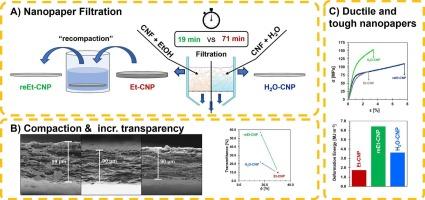高效制备坚韧的纤维素纳米纸
IF 12.5
1区 化学
Q1 CHEMISTRY, APPLIED
引用次数: 0
摘要
纤维素纳米纸是一种极具吸引力的材料,具有出色的机械和光学性能,但其生产速度缓慢。使用非水悬浮介质,特别是乙醇,纳米纸的生产减少了73%的过滤时间。由乙醇悬浮液制备的纳米纸比由水悬浮液制备的纳米纸具有更高的孔隙率,降低了它们的透明度和拉伸性能。用乙醇悬浮液加水再润湿纳米纸,然后干燥得到的纳米纸的密度与用水悬浮液制备的纳米纸的密度基本相同,这反过来又大大提高了机械性能和透明度。由乙醇悬浮液制备的重湿和干燥纳米纸的失效应变从2.8%增加到7.5%。由乙醇悬浮液制备的重湿和干燥纳米纸的失效应变也比由水悬浮液制备的纳米纸大(3.3%),尽管以拉伸强度和模量降低20%为代价,这被证明是由于网络中原纤维之间的键合作用较低。破坏应变的增加导致断裂功的显著增加。再湿和干燥处理也产生了高总透光率和雾度的纳米纸。本文章由计算机程序翻译,如有差异,请以英文原文为准。

Towards the efficient preparation of tough cellulose nanopapers
Cellulose nanopapers are attractive materials with outstanding mechanical and optical properties, yet their production is slow. The use of non-aqueous suspension media, in particular ethanol, for nanopaper production reduced filtration times by 73 %. Nanopapers prepared from ethanolic suspensions possessed higher porosities than those prepared from aqueous suspensions, reducing their transparency and tensile properties. Rewetting nanopapers prepared from ethanolic suspensions with water and subsequent drying yielded nanopapers with densities essentially the same as those prepared from aqueous suspensions, which in turn greatly increased mechanical properties and transparency. The strain to failure of rewetted and dried nanopapers prepared from ethanolic suspensions increased from 2.8 % to 7.5 %. The strain to failure of rewetted and dried nanopapers prepared from ethanolic suspensions was also greater than that of nanopapers prepared from aqueous suspensions (3.3 %) albeit at the expense of a 20 % decrease in tensile strength and modulus, which was shown to be attributable to a lower bonding contribution between fibrils in the network. The increased strain to failure results in significantly increased work of fracture. The rewetting and drying treatment also yielded nanopapers with high total luminous transmittance and haze.
求助全文
通过发布文献求助,成功后即可免费获取论文全文。
去求助
来源期刊

Carbohydrate Polymers
化学-高分子科学
CiteScore
22.40
自引率
8.00%
发文量
1286
审稿时长
47 days
期刊介绍:
Carbohydrate Polymers stands as a prominent journal in the glycoscience field, dedicated to exploring and harnessing the potential of polysaccharides with applications spanning bioenergy, bioplastics, biomaterials, biorefining, chemistry, drug delivery, food, health, nanotechnology, packaging, paper, pharmaceuticals, medicine, oil recovery, textiles, tissue engineering, wood, and various aspects of glycoscience.
The journal emphasizes the central role of well-characterized carbohydrate polymers, highlighting their significance as the primary focus rather than a peripheral topic. Each paper must prominently feature at least one named carbohydrate polymer, evident in both citation and title, with a commitment to innovative research that advances scientific knowledge.
 求助内容:
求助内容: 应助结果提醒方式:
应助结果提醒方式:


